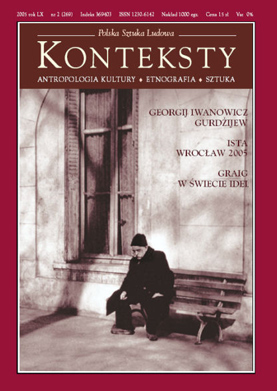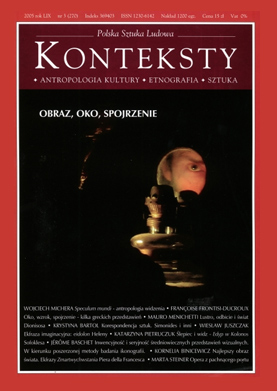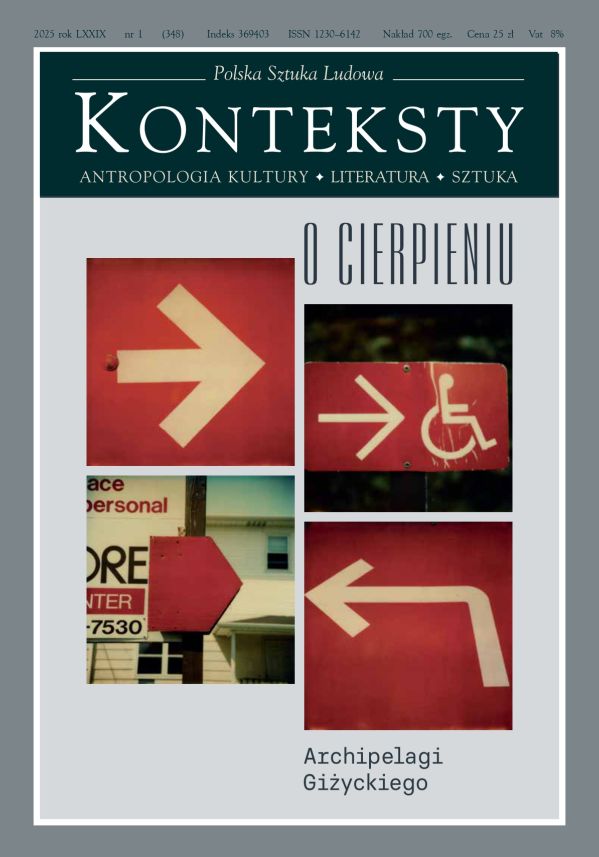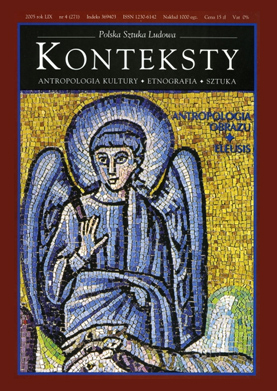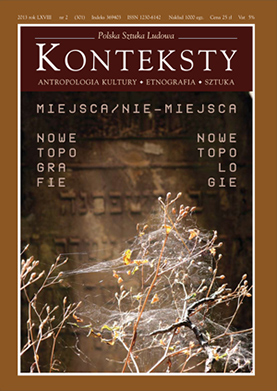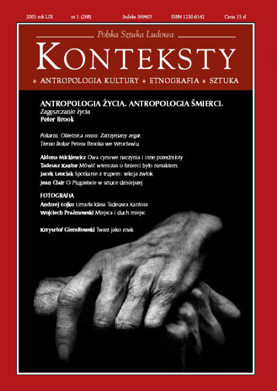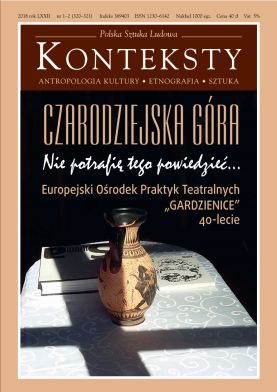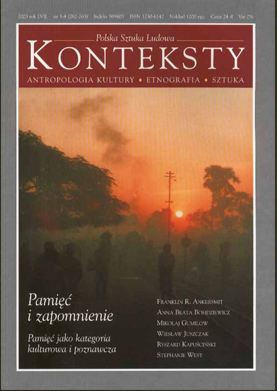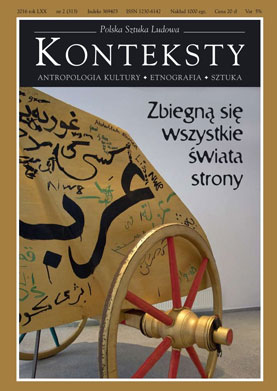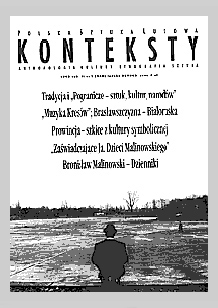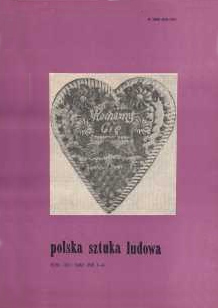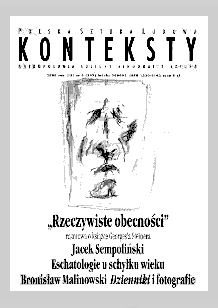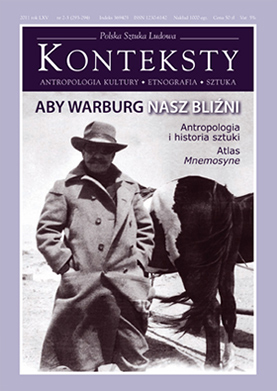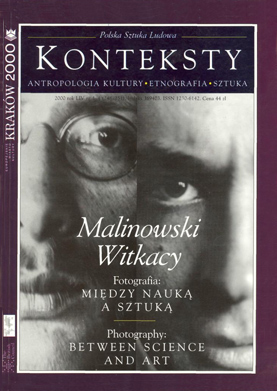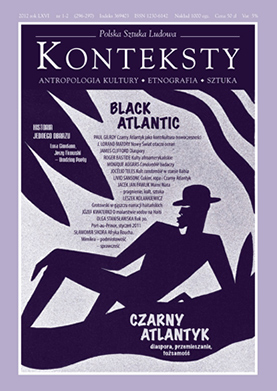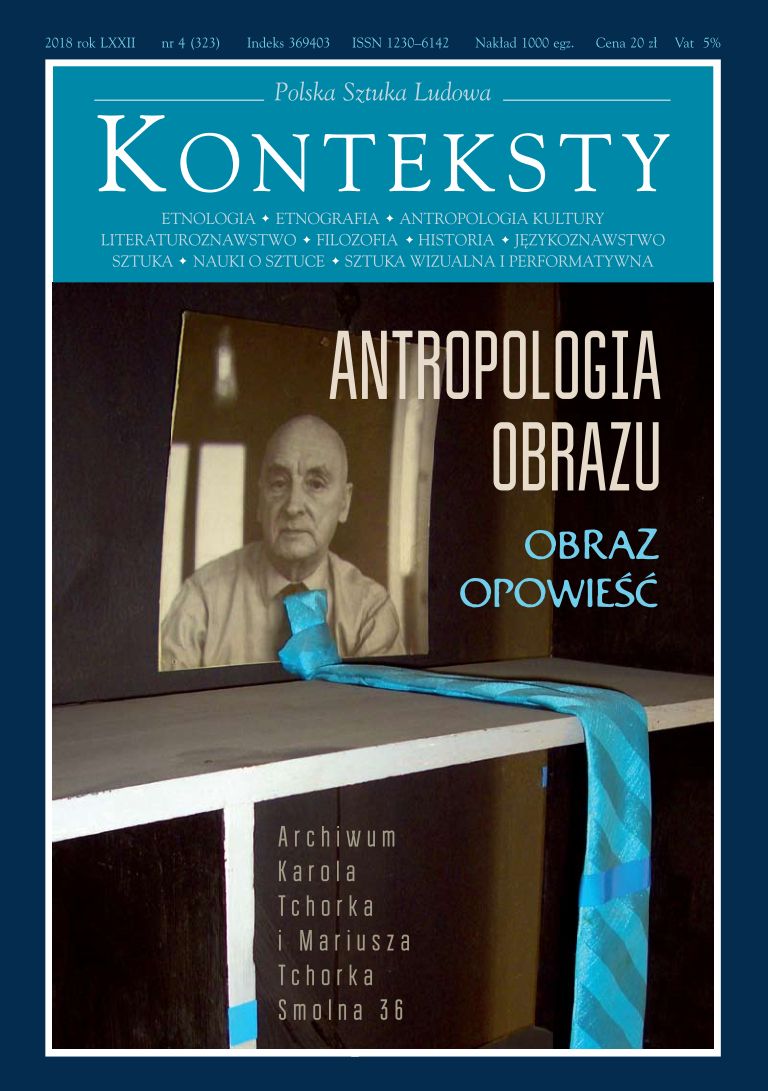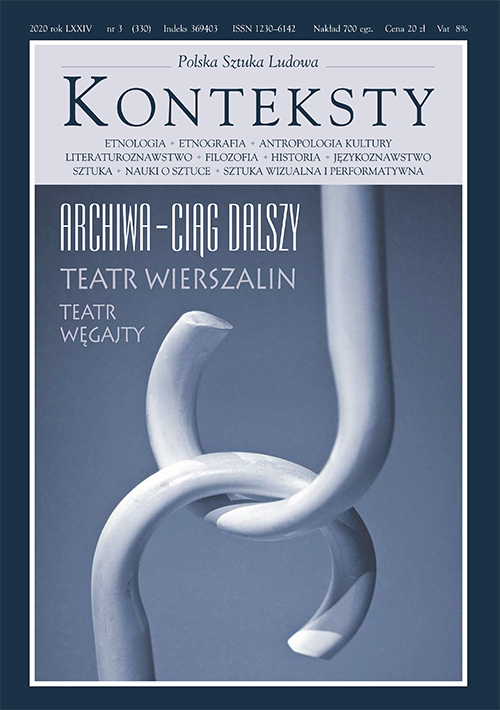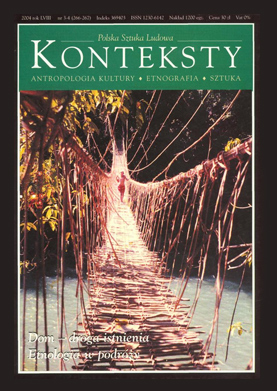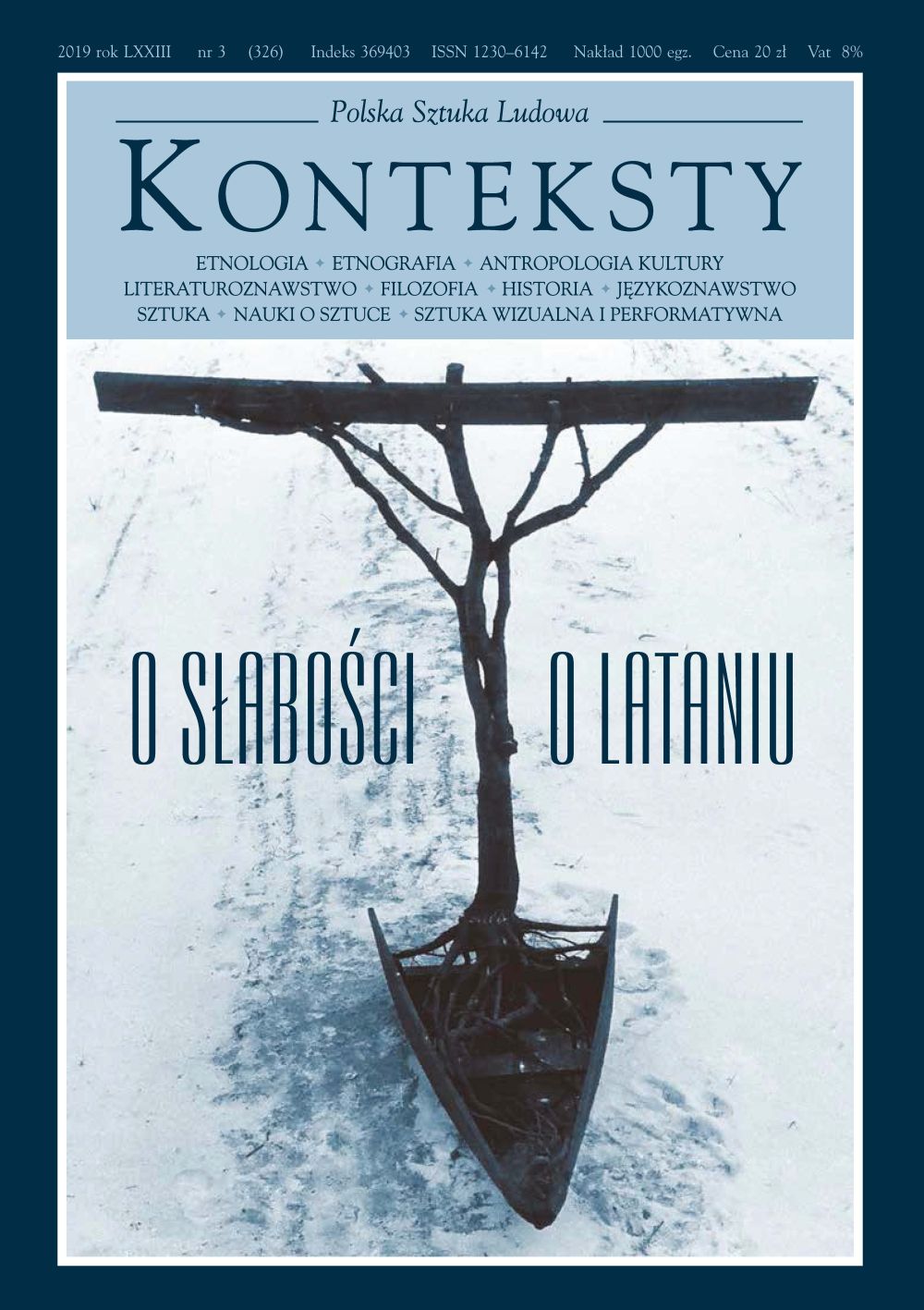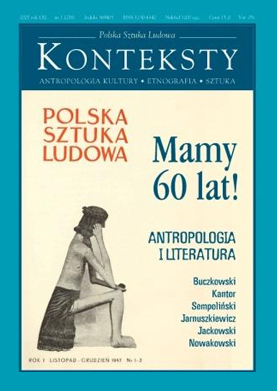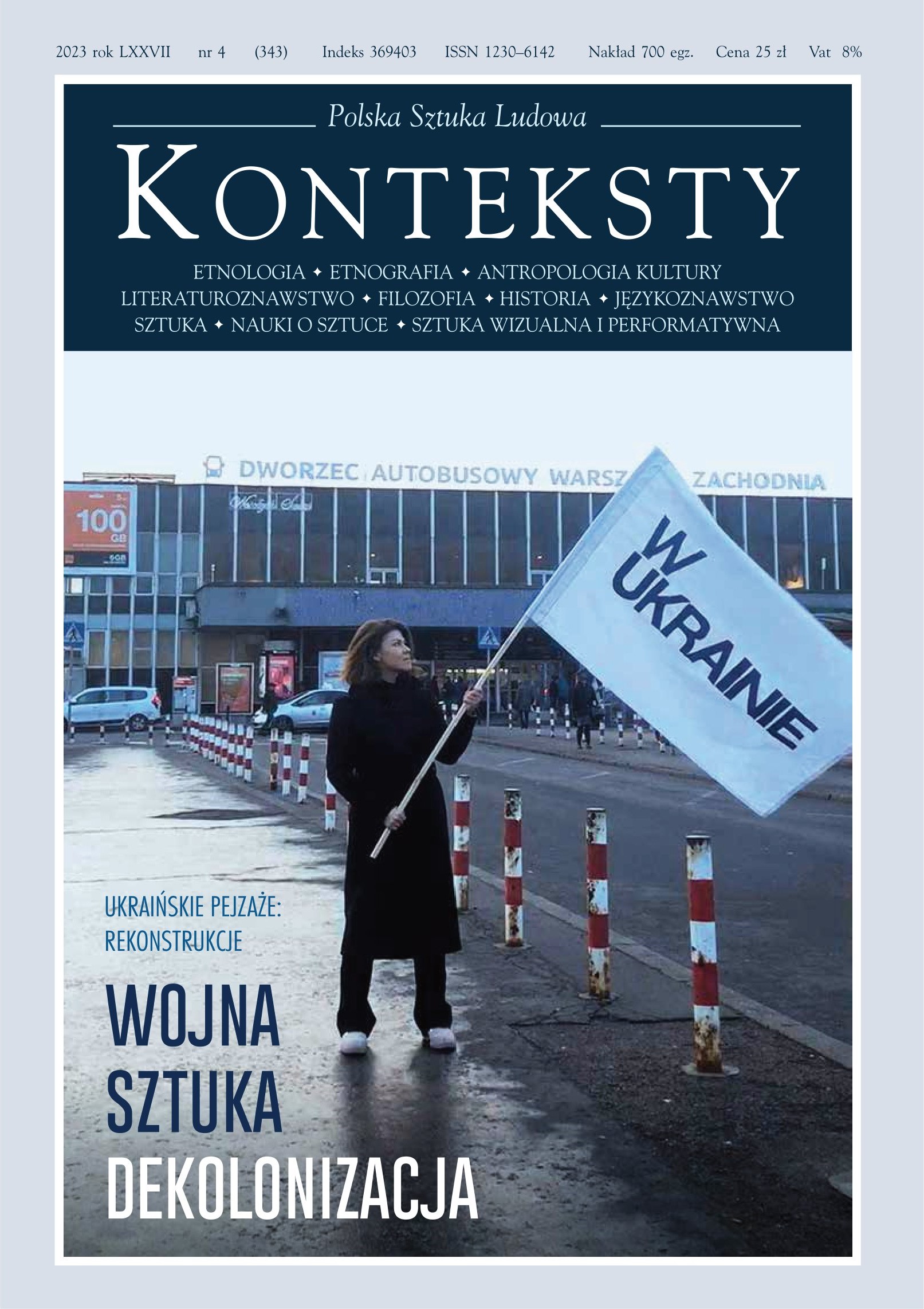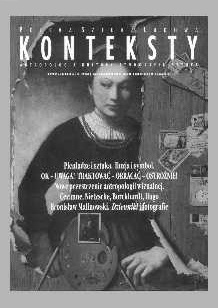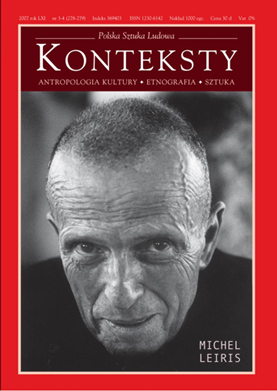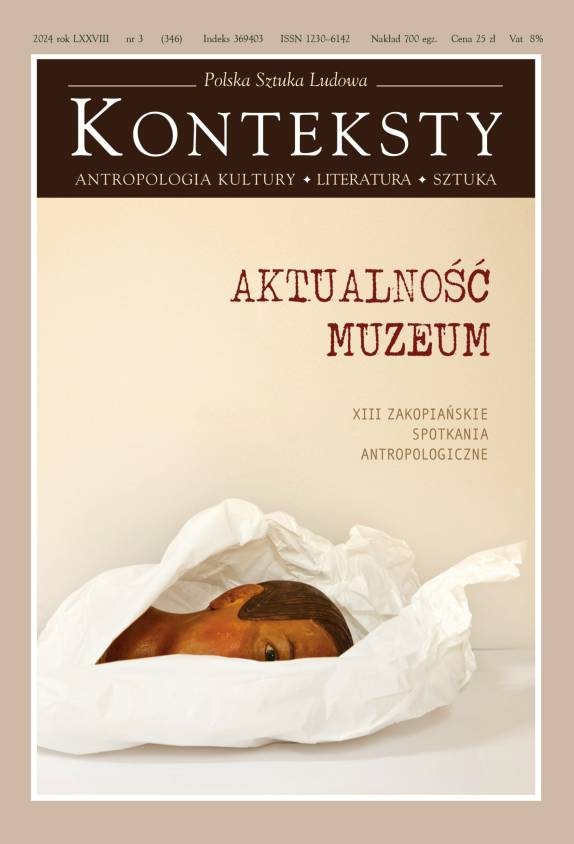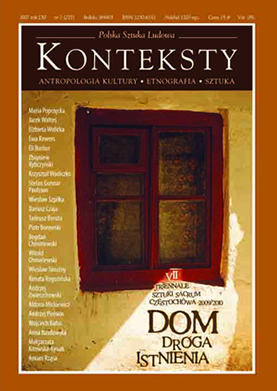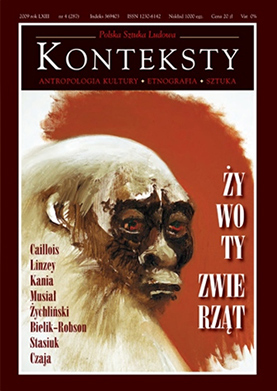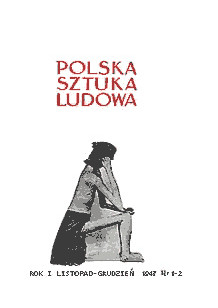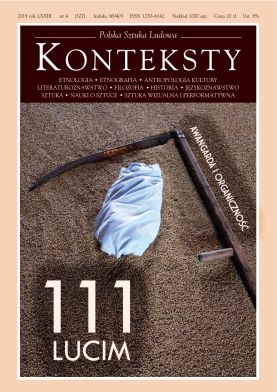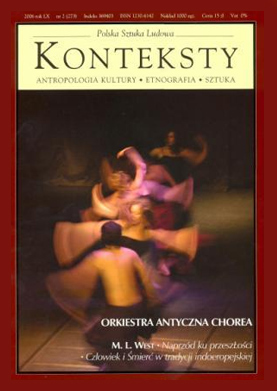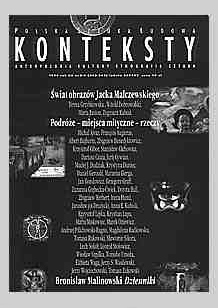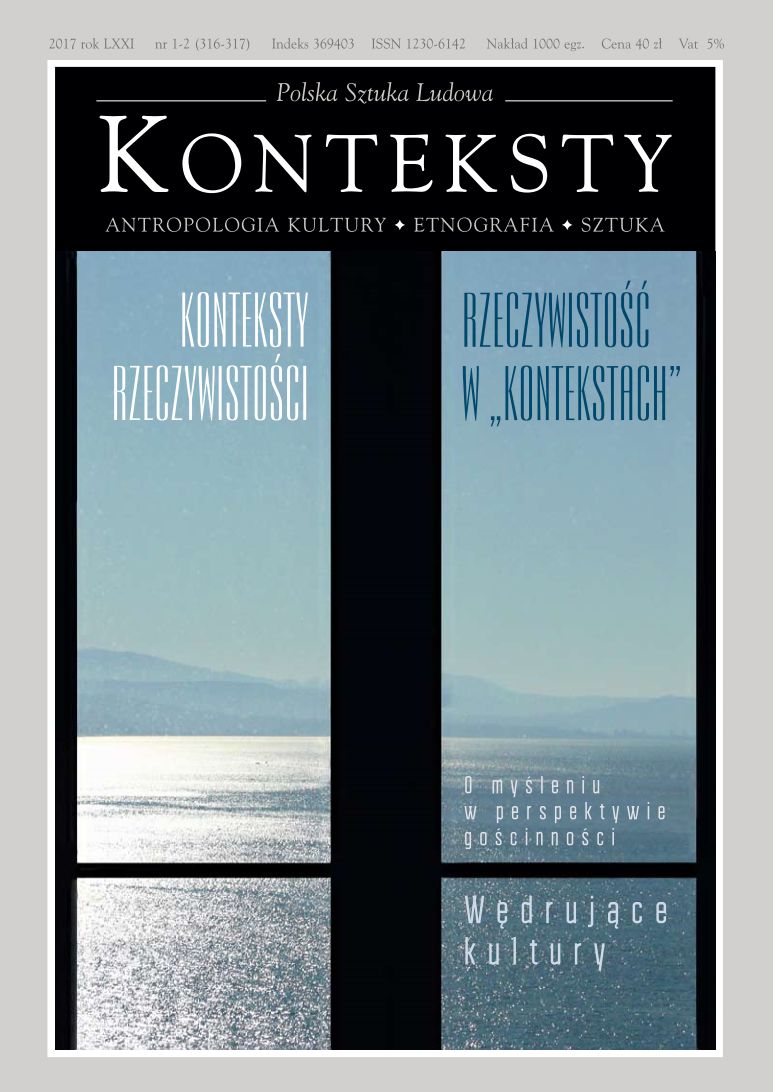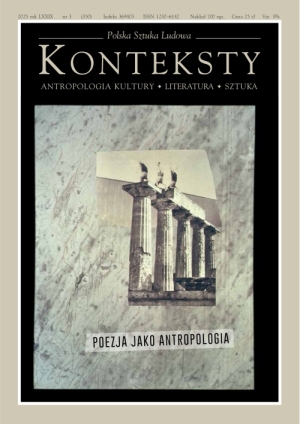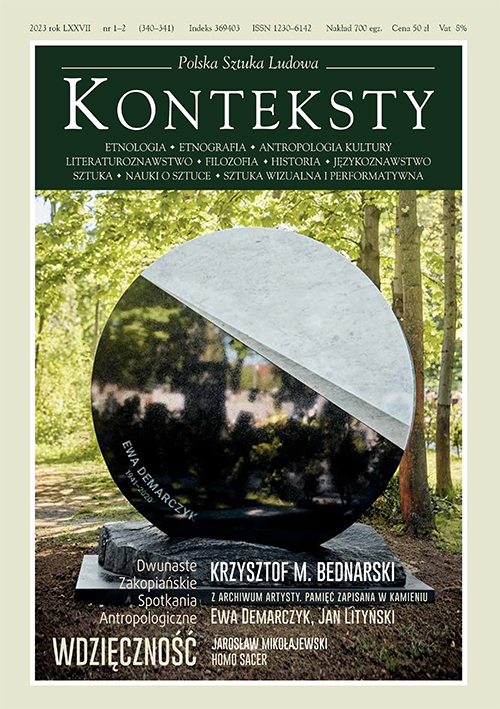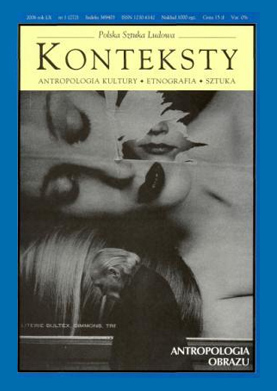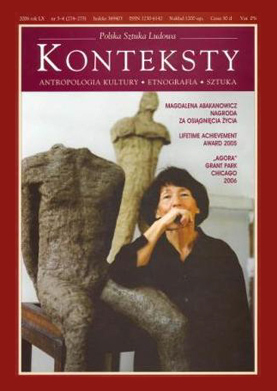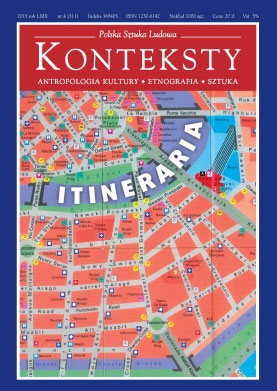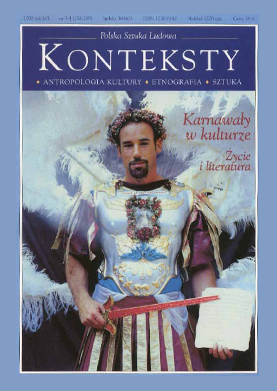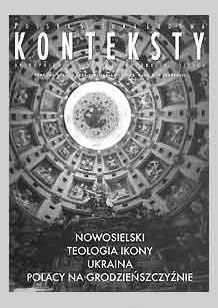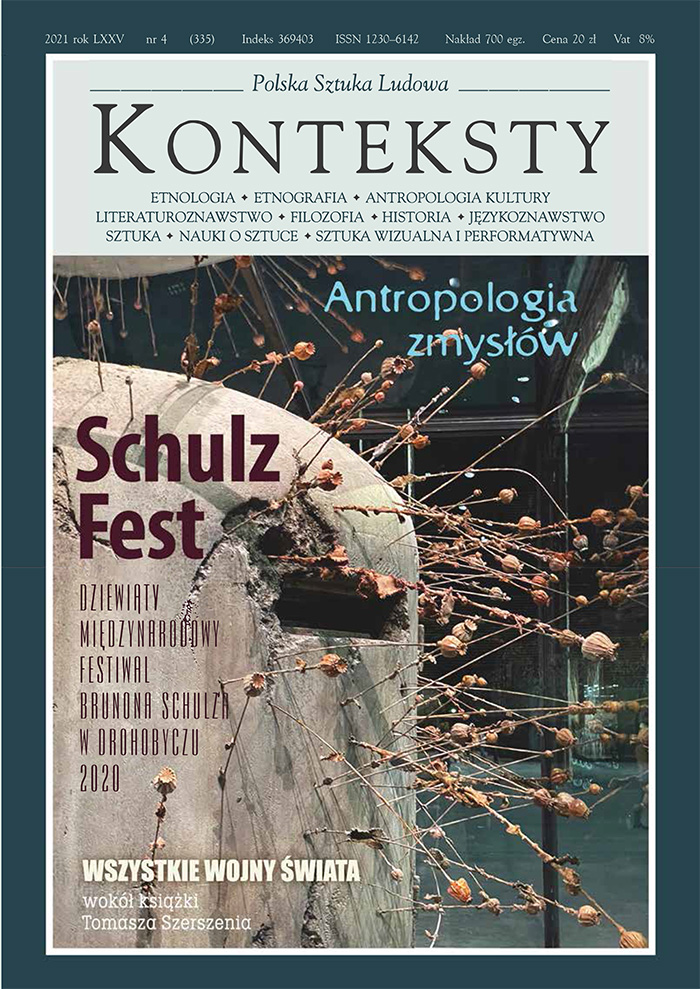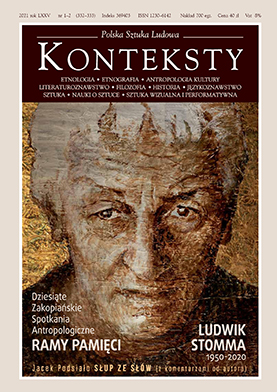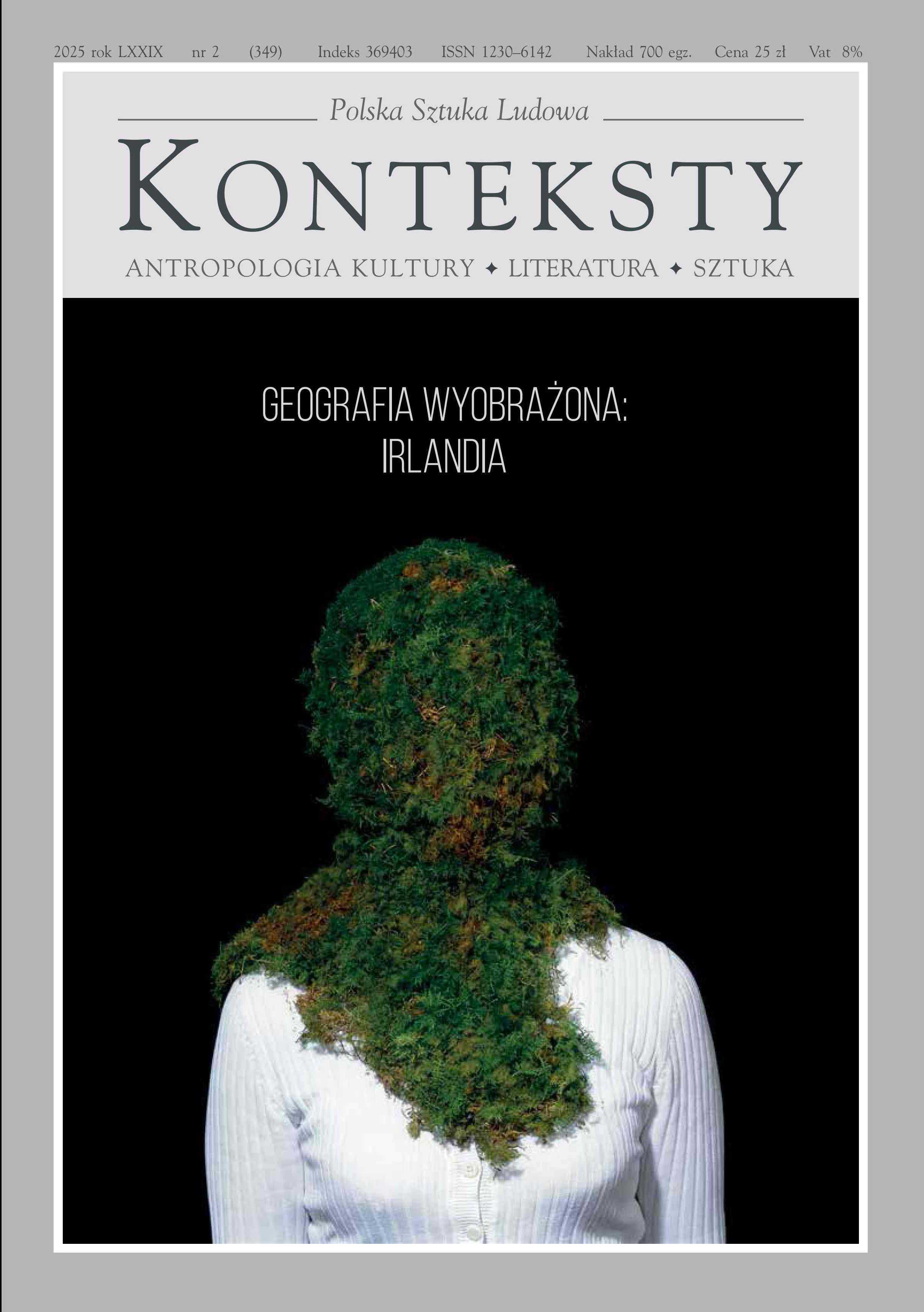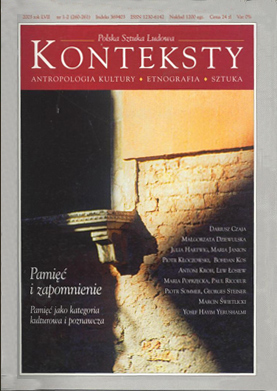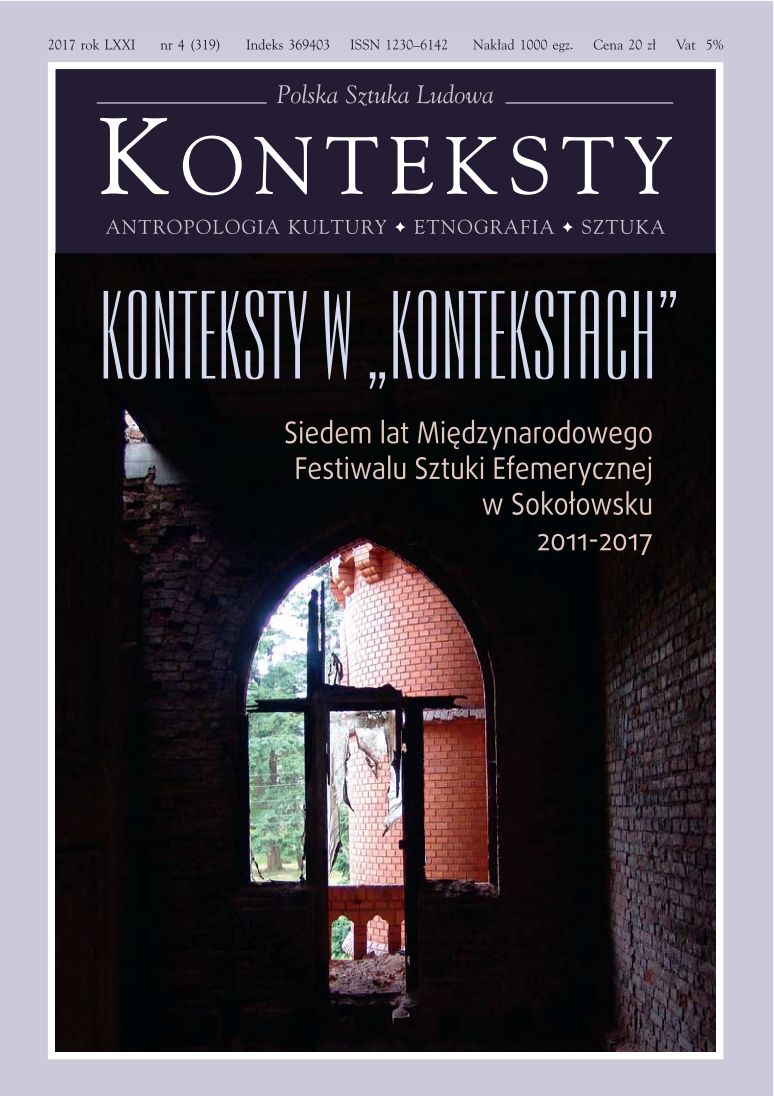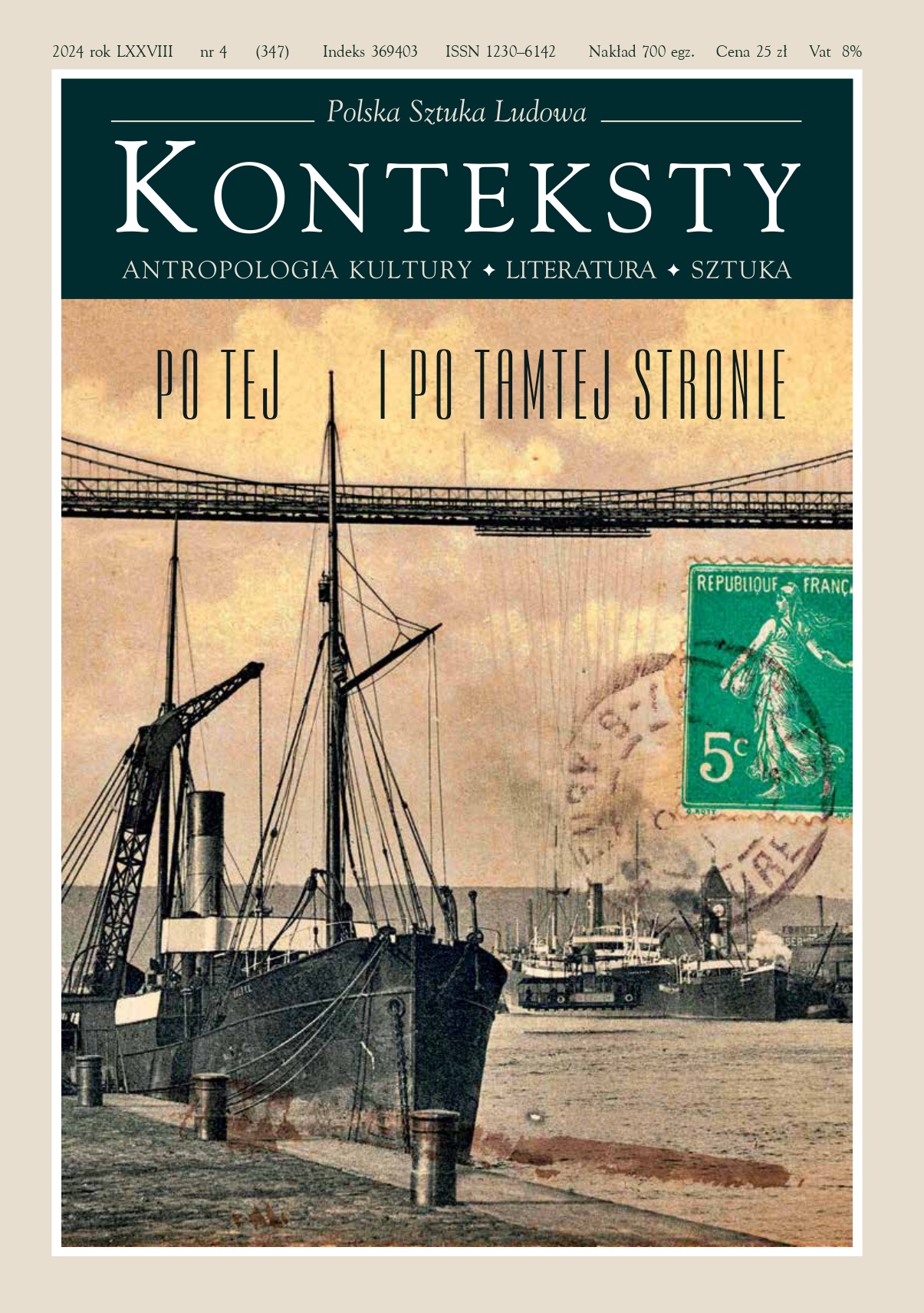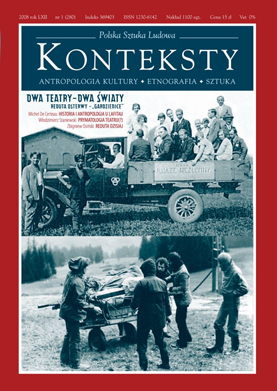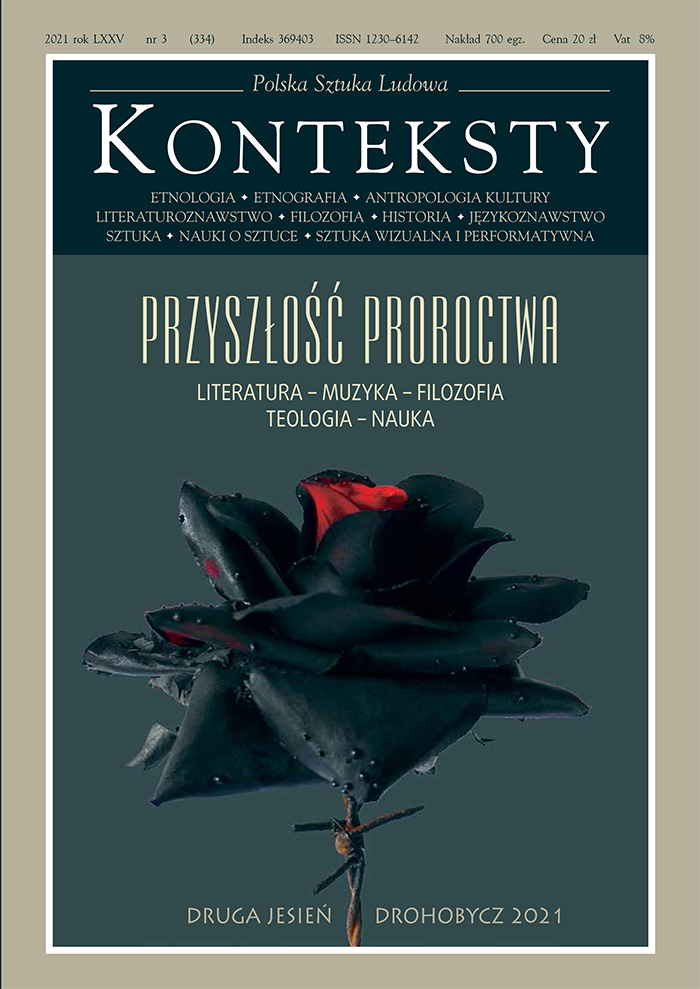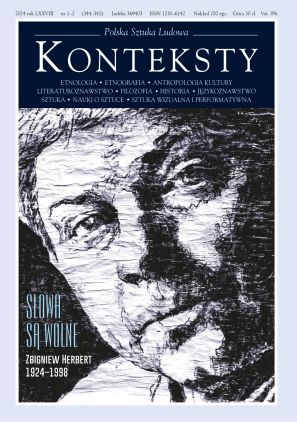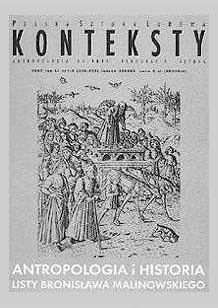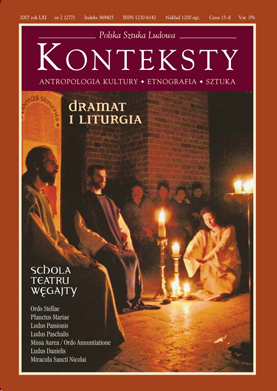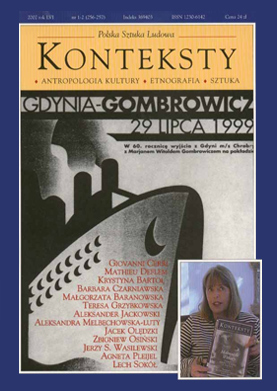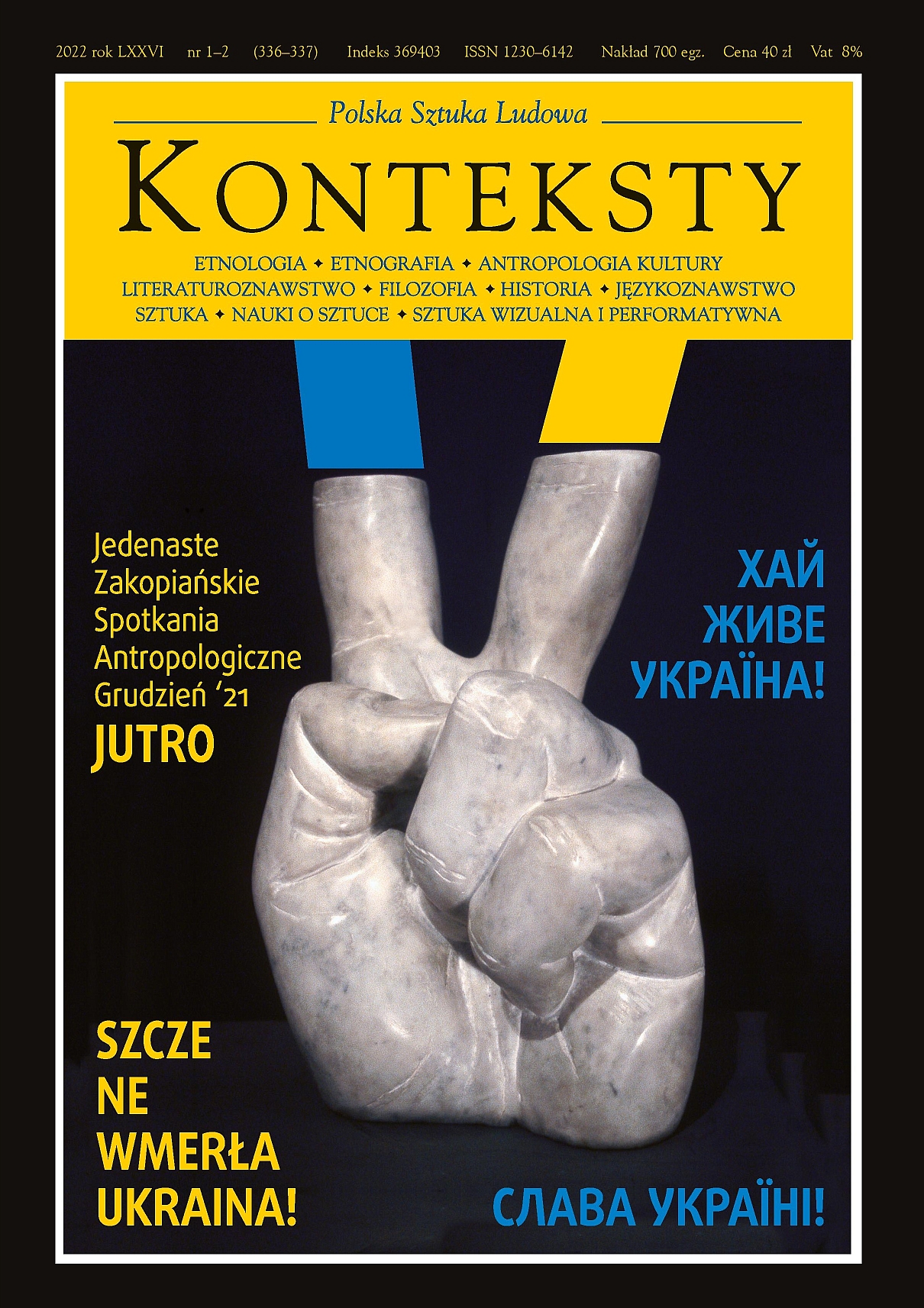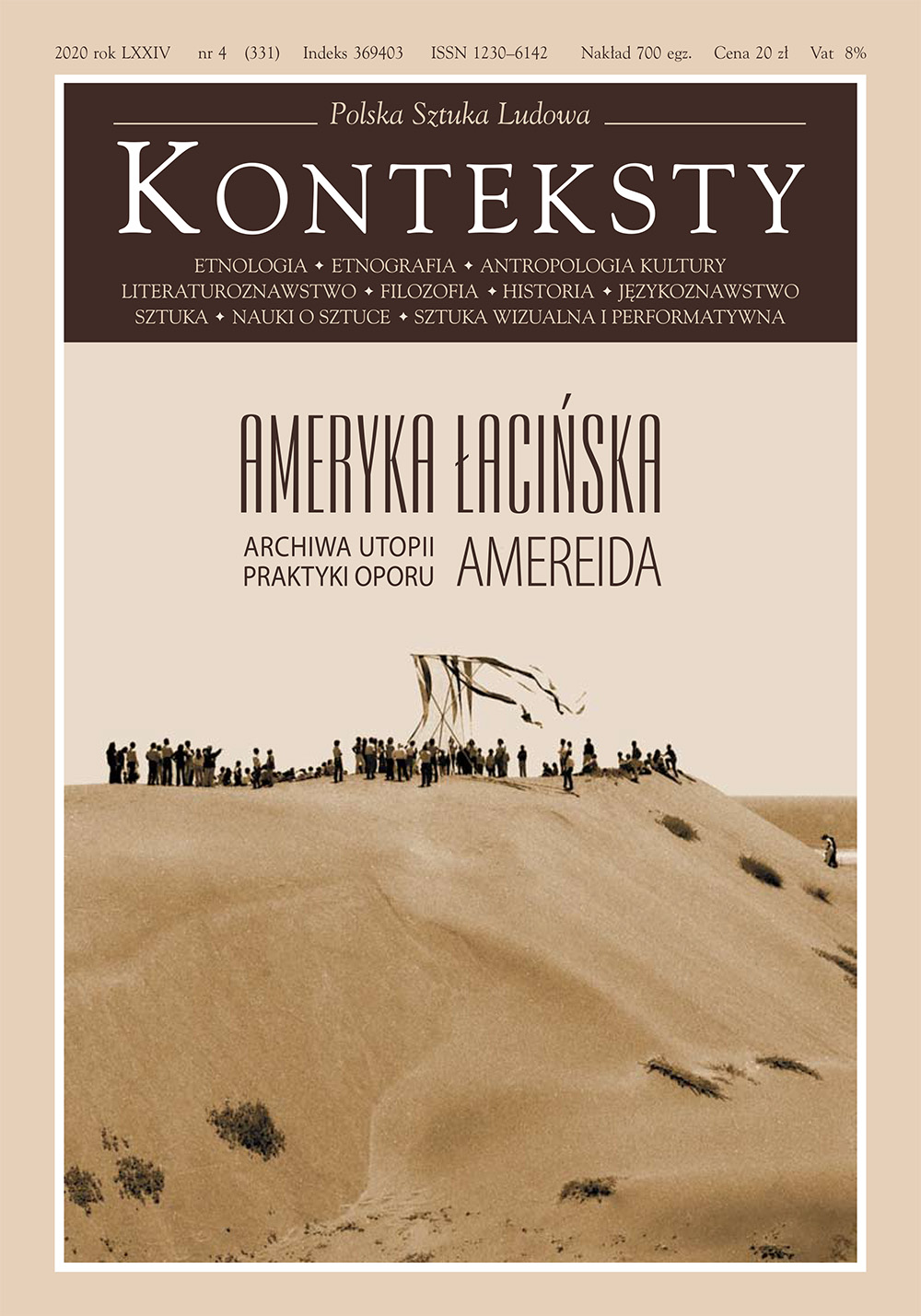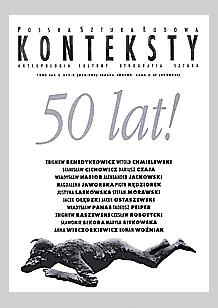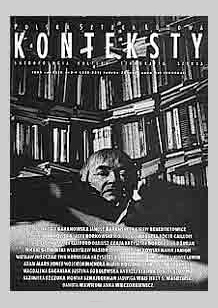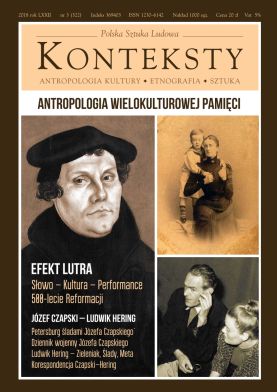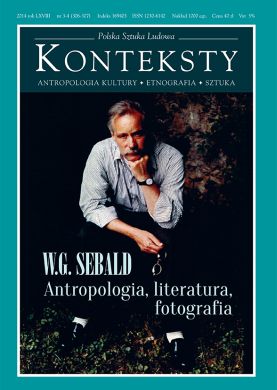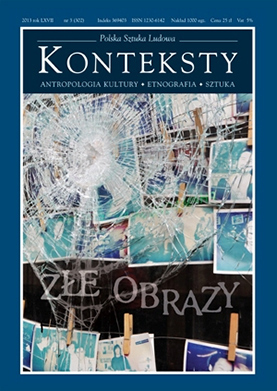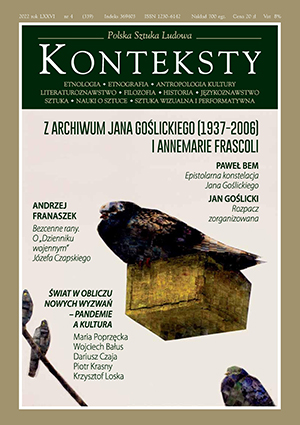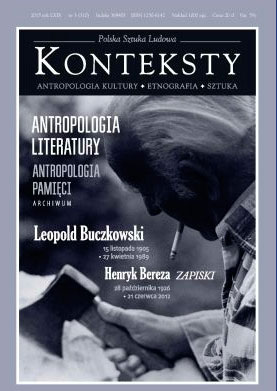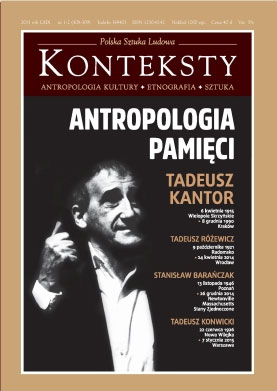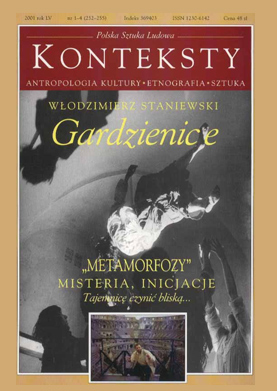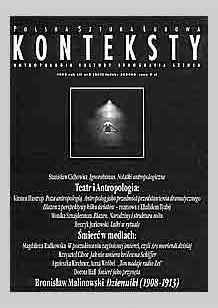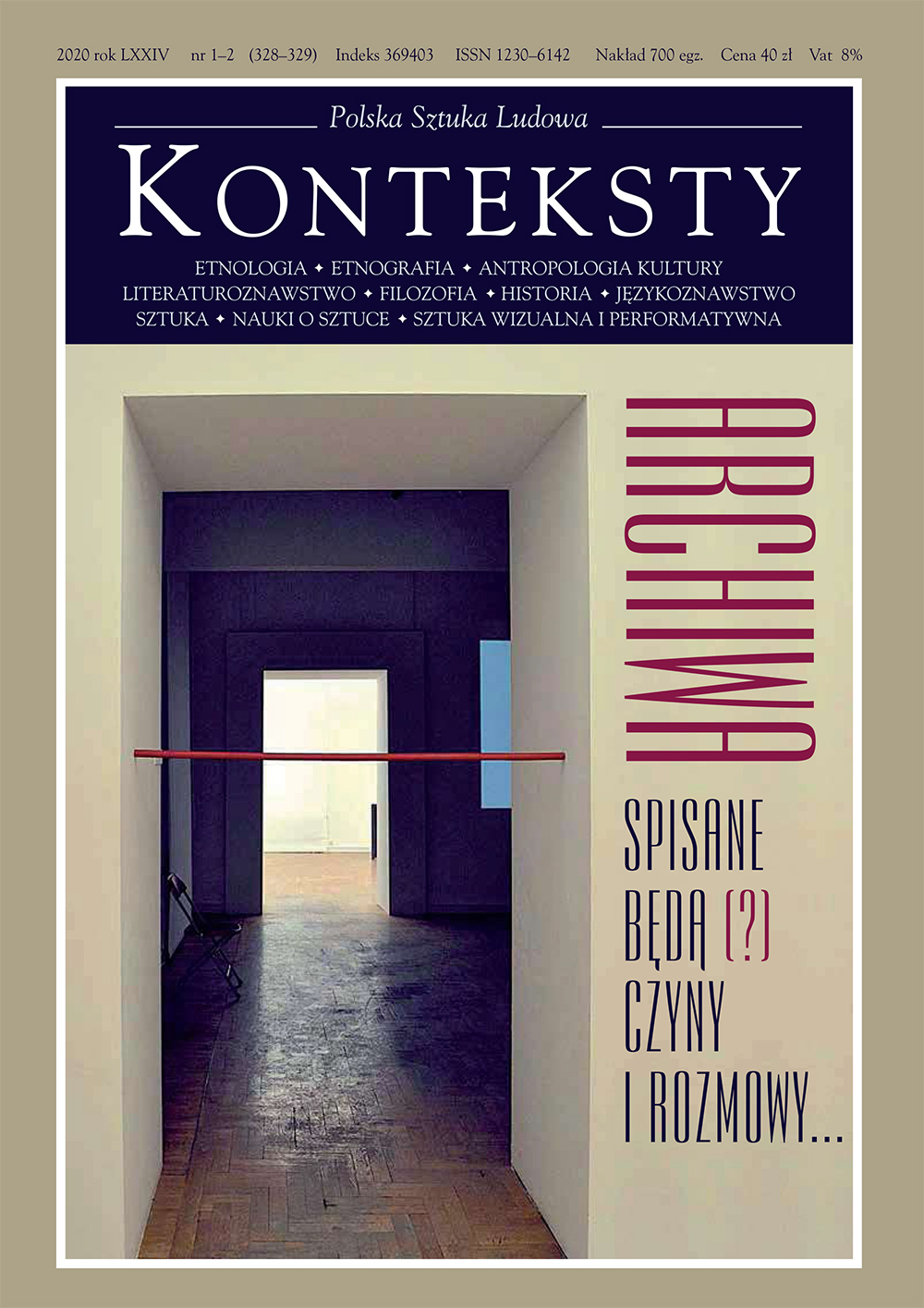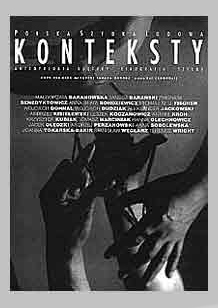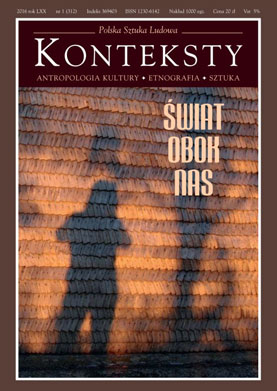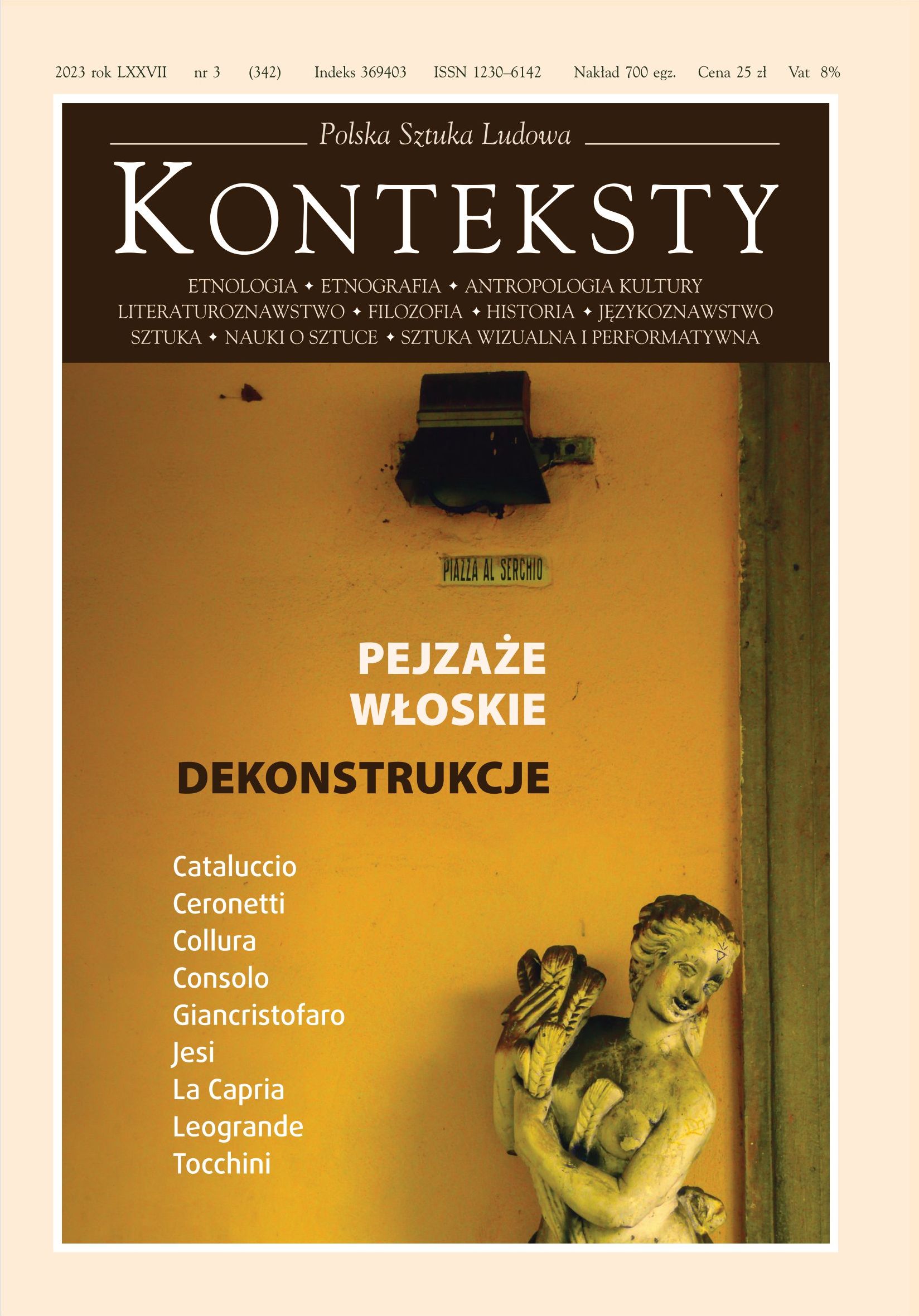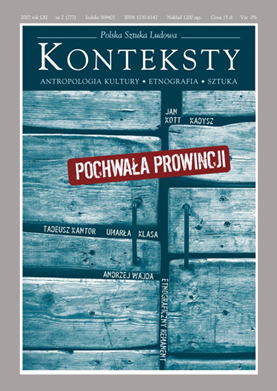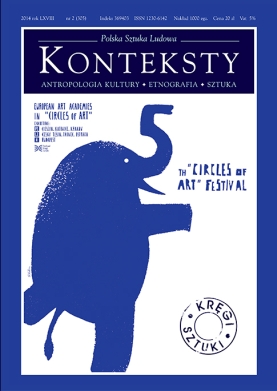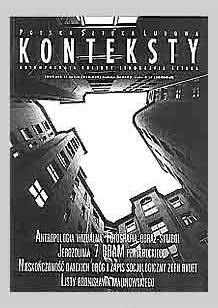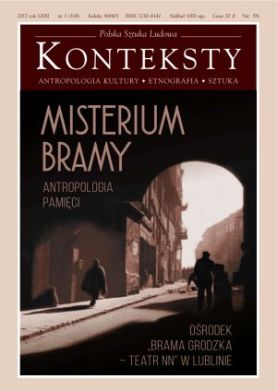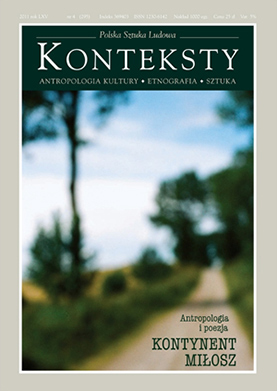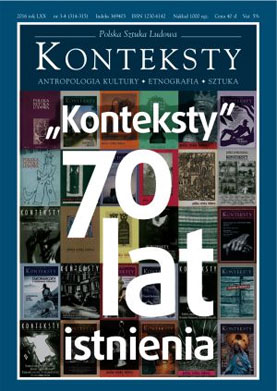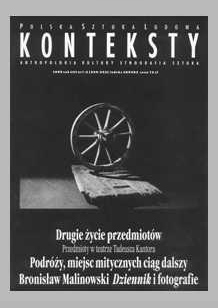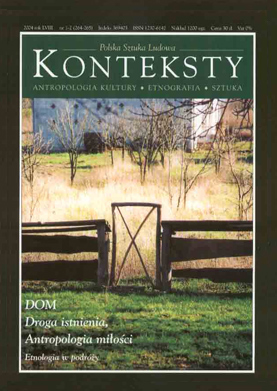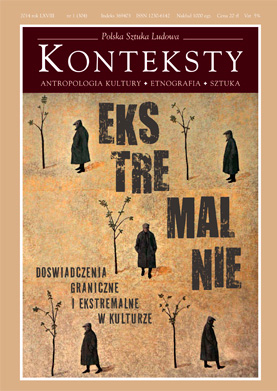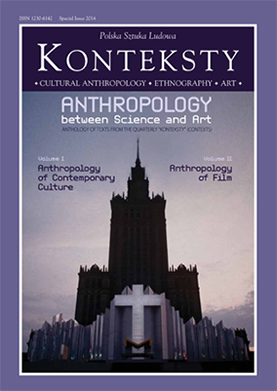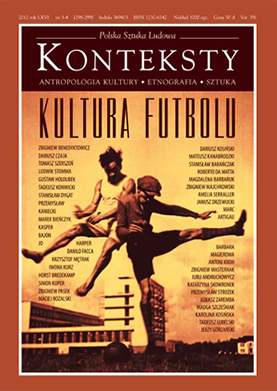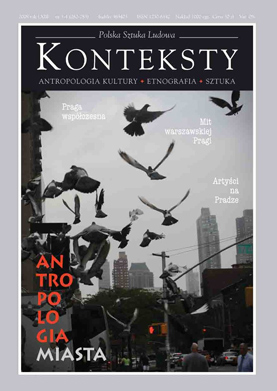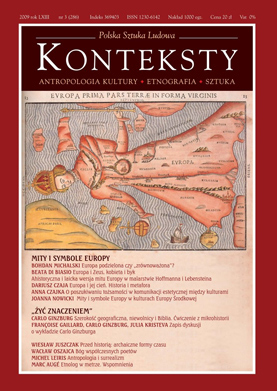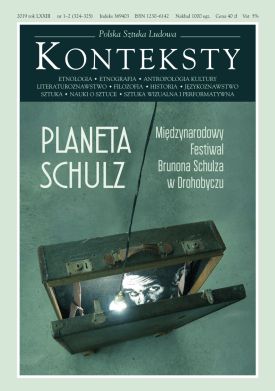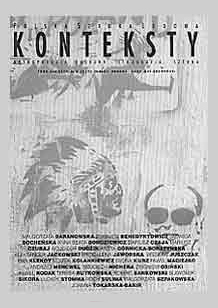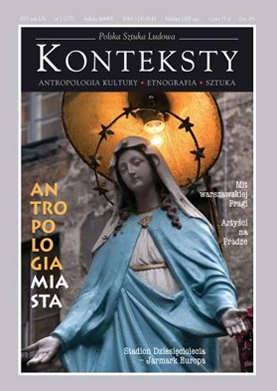Issue 2022/3 (338) - Visual Anthropology / Andrzej Różycki
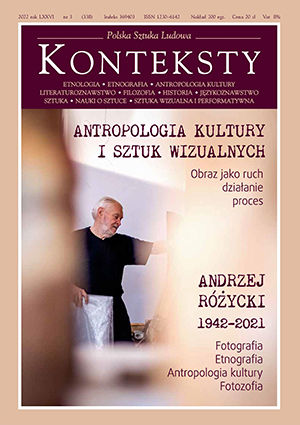
| *** | ||
| Jaś Elsner | Variable, Flexible, Smooth: Papyrus Drawings for the Production of Textiles and Replication in Roman Art  | 3 |
There is a relatively unexplored corpus of papyrus drawings made for and used by artisans engaged in the production of textiles in late Roman Egypt. The intentional indeterminacy in such sketches enabled both artistic flexibility and replicative (if not mass) production. An understanding of their employment in the fabrication of items both functional and decorative bears on far-reaching questions concerning replication, aesthetics, and artistic agency in Roman art generally, as well as on our understanding of the concept of the schema in the history of art. | ||
| Wojciech Michera | Missing Link in the History of Modernism: Postal Service  | 22 |
Studies on the visual culture of Modernism and the media at the turn of the nineteenth century have been dominated by the film and the origin of the cinema, whose outcome signified bypassing other domains of visual culture, important for the epoch. Wojciech Michera criticises the conceptions of such authors as Jean-Louis Comolli, Jean-Louis Baudry, Anne Friedberg, and Paul Virilio, by demonstrating their ahistoricism, anachronism, and habit of bypassing the actual social context and reception practices. One of the most prominent defects of those conceptions is a total avoidance of the social functioning of the postal network and its mass-scale distribution of picture postcards. In 1900 the latter were one of the most important media for disseminating photographic images showing actual events, discussed by the author in detail upon a single example – that of a fire which broke out on 8 March 1900 and destroyed the Parisian Comédie-Française. | ||
| Marta Leśniakowska | The “Living” Body – the Prosthetic Body. The Perspective of Contemporary Humanities the Anthropology of Reconstruction  | 35 |
An analysis of two studies of cases of bodily war experiences. One of the most important anti-war motion pictures is Johnny Got His Gun (1971), directed by Dalton Trumbo and based on his novel (1939). Due to the loss on the World War I front of his limbs, face, hearing, sight, and smell, the protagonist – a living shell – finds himself in an American hospital where he becomes the object of medical experiments, deprived by physicians of a right to euthanasia. A reference to the story appears in the activity of the American sculptor Anna Coleman Watts Ladd (1878–1939), who under the impact of her wartime experiences established Studio for Portrait-Masks, making prosthetic masks for the disfigured faces of soldiers. By analysing the problem of bodies outfitted with prosthetics, especially artificial faces conceived as tableaux vivants and confronting us with the human and the inhuman, the article deals with the question of power analysed from the perspective of neuroaesthetics, biopolitics, and the anthropology of reconstruction. In this case the author accepted the point of view of Gadamer, who in order to obtain simultaneous perception also from the vantage point of history as art discarded traditional aesthetics in order to indicate a direction of research focused on the manner of the existence of the image as an ontological event, and thus exceeding aesthetic awareness. | ||
| Łukasz Zaremba | Slavic Blackface. From the Archive of the Visual Colonial Complex of the Inter-war Period  | 44 |
An attempt at an initial recognition of blackface in Poland during the inter-war period – an element of spectacles, parades, the theatre, and dynamically developing visual culture, in particular its relatively new media such as the cinema and the large format billboard. The author argues that in Poland blackface was a recurring activity associated with the colonial culture of the period in question. By convincing the readers about Polish participation in imperial-racist imagination Łukasz Zaremba tries to predominantly prove that “Slavic blackface” was not as series of random events, but an anthropological praxis. As such, the latter reflects premises, superstitions, and stereotypes concerning distant oversea foreignness, thus revealing, first and foremost, inner tensions in a country of “colonialism without colonies” and suffering from a “colonial complex”. The presented article is an introductory and, at the same time, first presentation of the premises of the Colonial complex in Polish culture of the inter-war period project. | ||
| Anne Reverseau | Writers and Their “Image Gestures”  | 56 |
This text presents the research topics of ERC Handling – UC Louvain (Belgium), dealing with the manipulation of concrete images by writers from the end of the 19th century until today. What are the specificities of writers’ image gestures, such as collecting, cutting, pasting, hanging on walls, and so on? Why and how do these gestures replicate and differ from other kinds of “image gestures”? The article focuses on contemporary French-speaking writers familiar with visual culture. | ||
| Maciej Topolski | What Is Contact?  | 61 |
The topic of this article is the concept of “contact” examined within the context of reflections on the sense of touch conceived as the sense of a bond. The latter is considered upon the level of a single human body but also more extensively – as a possibility of creating relations with that which is inhuman. | ||
| Marta Leśniakowska | The Scent of Painting – the Scent of Art Sensuous Theory  | 70 |
The affective dimension of experience conceived as a factor organising the psyche is an essential current of the new humanities which accept the “sense-centric“ and multi-sensory perspective derived from French existential phenomenology and based on neuroaesthetics and osmosociology. It resolves the question concerning the manner in which assorted artistic practices are received as a direct multisensory experience upon successive stages of the origin and functioning of art – from the artist’s studio, where art is produced, to the museum/gallery, where it is presented. For the first time in Polish literature the text analyses the participation of scent in the creation and perception of painting by engaging the sensuous theory (Vivian Sobchack) devised by so-called film studies 2.0. The author cites numerous statements made by artists and recipients of art dealing with this theme as well as fragments of the belles lettres, at the same time indicating contemporary art and exposition practices based on scent as well as most recent scientific research (library of the scents of historical objects). | ||
| Cezary Wąs | The Problem of Movement in the Philosophy of Painting by Maurice Merleau-Ponty  | 78 |
Maurice Merleau-Ponty outlined a new ontology based on analyses of sensual experience. In his philosophy he used Paul Cézanne’s paintings interpreted as an attempt to record the primeval experience of the world. The world studied by the painter is a constantly emerging and not a permanently existing one. Its hidden principle is, therefore, movement which remains impossible to perpetuate both in philosophy and in painting. The portrayal of movement has been the intention of artists upon many occasions, but this problem requires a separate study. | ||
| Szymon Wróbel | Matters of Fact or Artur Żmijewski’s “The Pleasures of Ordering Evil”  | 84 |
In the introduction to his latest project, The Pleasures of Ordering Evil, Artur Żmijewski writes about the violence that happens around us and leaves traces-effects – in bodies and landscapes, in nature and human faces. Żmijewski seems to say that violence is omnipresent and all-powerful. In the text, I take up the challenge posed by Żmijewski and ask the question whether all kinds of violence should be equal and considered as equivalent? I argue that violence should be taken out of the banal formula, i.e. we should not so much reveal violence but rather the “triviality of violence” should be extracted from the violence of the world. I ask also the question: how to talk about violence and how to represent it? In order to answer this question, I juxtapose Żmijewski’s project with the paintings of Francis Bacon. In the works of Bacon and Żmijewski we encounter violence which has two different meanings: violence understood as banal aggression and violence understood as starting a process. The latter is beneficial. Finally, I put forward the thesis that realism is no longer valid today. Only “matters of fact”, detective archiving of material facts has power. To start thinking, we need more than realism, i.e. the force of fact. Perhaps Żmijewski offers us a kind of “practical realism” or “agential realism” showing our entanglement in the world. | ||
| Marta Smolińska | Incessant Motion of History: “East Side Story” by Anne Peschken and Mark Pisarsky as an Anachronic Embodiment of the Experience of Migration and Settlement in the so-called Recovered Territories  | 95 |
This text is an analysis of a series of pinhole photographs, by Anne Peschken and Mark Pisarsky (Urban Art), entitled East Side Story. A photo research on migration and arrival stories, 2019 on-going. The theme of the series concerns the settlement of Poles in the so-called Recovered Territories after the end of the Second World War. The main thesis is that these photographs are a model example of images which, while addressing the theme of migration in the representational layer, also activate the processual and migratory nature of visual forms themselves. In order to substantiate this thesis, the East Side Story project is examined in the following contexts: critical border (art) studies; H. Belting’s anthropology of the image; memory studies; re-enactment; the blurriness of images made with a pinhole camera; the medium as an infrastructure of mobility; A. Berleant’s re-thinking aesthetics and the notion of aesthetic embodiment; and anachronism according to G. Didi-Huberman and J. Rancière. | ||
| Joanna Tochman | Family Constellations. Joanna Piotrowska’s “Frowst” Photo Book  | 112 |
An analysis of Frowst by Joanna Piotrowska against the background of family photography in Poland and the conventions devised by it at the turn of the nineteenth century. The author analysed factors impacting ways of construing the convention of the family photograph and the mechanisms of producing family myths and shaping a certain depiction of the functioning of the family. By applying the conceptions of “stage” and “backstage” conceived by Erving Goffman the presented text distinguishes a new tendency in family photography, analysed upon the example of Piotrowska’s work. | ||
| Martyna Śmiłowska | Ways of the Existence of the Process in “Needle Work” by Teresa Tyszkiewicz  | 127 |
An attempt at capturing the specificity of the processual character of “needle works” by Teresa Tyszkiewicz and its symptoms. The text presents the phenomenon of coexistence in elements of ephemeral art and those typical for traditional painting, the needle work method as such and resultant material objects. The author discusses the way in which the artist intervened into the surface of canvases and the manner in which she comprehended this process. The article also contains an interpretation of the organic character of artworks embedded in the context of feminist conceptions of subjectivity as well as an analysis of their tactile potential. | ||
| Magdalena Zych | Hej kolęda, kolęda  | 137 |
The point of departure of the presented text is a polemic with Adam Leszczyński’s Facebook entry condemning the inclusion of a photograph showing a mask of a Jew among a group of carollers (supposedly without a commentary), featured at the Ethnographic Museum in Cracow. In her reply the author of the text, simultaneously one of the Museum curators, not only explains the intention of including this particular depiction into museum space but also reconstructs the entire complex context and history of the motif of the Jew mask among the carollers. At the same time, she poses a question about the role played by an ethnographic museum and the limits of publicistic commentary (and associated abuse). "I found masks showing Jews and Gypsies, present in assorted caroller groups, disturbing. Upon numerous occasions I was asked why do we show such caricatures? What about the feelings of Jewish and Romani visitors, facing such depictions of themselves and asking: is this my museum, a museum about me? How did the Jew character find himself among carollers? Did this take place when older carol singing became linked with the Church ritual theatre? How did the Jew-rabbi appear amidst the canon of carollers (together with King Herod) or the Jew Trader among those singing together with the turoń? Perhaps this is a distant trace of the commedia dell-arte, an echo of the Pantaloon (Venetian trader) dramatis persona and the Servants? Or is the reason entirely different? It is worthwhile to exploit the opportunity provided by the omittance of the commentary on the part of a recognised journalist and historian, as well as his propagation of false information about its absence. The crux of the matter is, after all, the existence of a mask portraying a Jew as pars pro toto of the entire permanent ethnographic exhibition. This is not the first time when the nature of this object, i.e. the disguise and hence the disclosure of exiting but concealed contests, makes itself known. The context of the ethnographic museum constitutes an excellent backdrop for such reflections”. | ||
| Roma Sendyka, Natalia Judzińska | Material Dimension of the Crisis along the Polish-Belarusian Border: Places and Objects  | 142 |
The ongoing humanitarian crisis on the Polish-Belarusian border did not attract mass public attention in Poland or in the world, also the media interest is limited. Rare visuals of asylum seekers and migration conditions are rather provided by activist portals and people involved in providing humanitarian aid, thus they remain in the circulation of communities working to solve the crisis. Consequently, access to knowledge about the conditions of the migration experience across the Polish border is limited. Observing the material background, the traces of migration, both in the sense of its topography and its instrumental equipment, allows us to get closer to the inaccessible information. The authors propose a preliminary typology of migration sites, as well as objects used during migration. They argue that such a research strategy not only examines migration processes through their secondary symptoms. It can be understood as an ally gesture towards asylum seekers. Material analysis makes it possible to reveal the experience of migration in such a way as not to infringe on the precarious security of people on the move. | ||
| Emilia Olechnowicz | Aby Warburg: Paintings in Motion  | 157 |
Warburg. Panorama recepcji – this volume published by słowo/obraz terytoria includes Warburg’s reflections on a current of studies about representation and expression, revealing a number of paradoxes ascribed to the German researcher. The latter’s work appears to be suspended between two poles: that which is logical collides with that which is emotional, mania (personified by nymphs) confronts depression (a Greek water deity). Nonetheless, those tensions did not limit Warburg’s research imagination but activate it. While dealing with paintings Warburg did not aim at the construction of interpretive tools serving the establishment of control over the senses but was interested rather in mutual relations between paintings and their wanderings, the uncoordinated motion of paintings and images which change in time, migrate between countries, and absorb new meanings. The Warburgian conception of the painting vividly reveals the performativeness of images comprehended predominantly as the iteration of the painterly gesture and the intentionality of deciphering it, as a dynamic of representation and abstraction. Warburg was interested in the bodily expression of emotion or perhaps the “painterly revelation of the body”: on the one hand, the expression of states and emotions by means of gestures, grimaces, and motions and, on the other hand, the transformation of the body into a painting within the creative process. | ||
| *** | ||
| Marek Janczyk, Iwona Święch | Andrzej Różycki. Photographer and Photosopher  | 165 |
A synthetic summary of the oeuvre of Andrzej Różycki, with particular emphasis on his photographic theory and praxis. The point of departure for auteur interpretations of the artist’s works is an evocation of a monographic exhibition featured in 2004 at the Museum of the History of Photography in Kraków. The conception of this text, partially referring to the scenario of the exhibition, constitutes an attempt at a successive retrospective approach to the multi-motif oeuvre of Andrzej Różycki, made almost twenty years later. An essential supplement of the theme interpretations are references to texts accompanying the artist’s exhibitions. Różycki’s compositions are universal and, at the same time, personal. His self-presence in art is linked with expressing ambivalent stands spanning from emphasis on the rank of the creative mission to an unconventional artistic joke and sometime irony. A successive, equally essential motif is reference to the sacrum sphere, in which the presence of spirituality is linked with an awareness of the infinite rank of the past and memory. The ambiguity of existential reflection is also expressed by works disclosing time continuity while simultaneously pertaining to the complexity of the meanings of reality, in which prosaic motifs are linked with symbolic-mystical ones. Many of the compositions, in particular those created by using the strategy of the quotation, disclose a mood of nostalgic reflection or melancholy. Conclusions of the presented text deal with the rank attained by Różycki’s art. Its special features include originality and a constant striving towards creative autonomy expressed in, i.a. a relentless undermining of the ideological stereotypes of art and a search for new formal solutions. The works of Różycki indubitably constitute one of the most significant phenomena not only in the history of photography but also of twentieth-century Polish art. | ||
| Hubert Czachowski | Path of the Angel. On Andrzej Różycki  | 172 |
A description of the exhibition: Przejęcia (Między zbieractwem a fotozofią (Import/ance/s. Between Hoarding and Photosophy) featuring works of the acclaimed Polish photographer Andrzej Różycki. Upon this occasion – which proved to be the last show held during the artist’s lifetime – Różycki for the first time contrasted two parts of his works: on the one hand, artistic photographs and objects, and, on the other, his collection of folks, naïve, and provincial art (hand-coloured photographs – so-called monidła). The intention was to demonstrate the way in which both parts exerted a mutual impact within his entire oeuvre. The avantgarde and provincial culture – a strange combination considering that the world of the province and folk culture is, ex definitione, conservative. But – Różycki maintained – it provokes questions about the foundations of being even if it is capable of explaining them in its own manner. This is the reason why this particular world appears to the artist to be important and inspiring. Here he discovered truths about its nature and the possibilities of becoming acquainted with it. This entails not only artistic experiences but also existential and even transcendental ones. The Różycki oeuvre is permeated by a conviction about the existence of the Spirit, both in the world of Nature and human undertakings. For many years he sought the Spirit predominantly in the photograph, achieving an analytic penetration of photographic being. According to Różycki the same Spirit penetrates the works of folk and naïve artists. His discovery of the Spirit in photography and the world was possible thanks to experiencing, at the very onset of the artistic path in the 1960s, a meeting with an unknown little girl strolling around a village cemetery, immortalised in the already classical Zatruta studnia (Poisoned Well) and Melancholia cmentarna (Cemetery Melancholy), two works absent at Przejęcia, although it was during this encounter that he became “touched by the Spirit” in the same manner as Juliusz Słowacki in the course of a meeting in Pornic more than a century earlier. | ||
| Katarzyna Gębarowska | Archive of Beautiful Love  | 179 |
Archiwum Pięknej Miłości (Archive of Beautiful Love) is part of the tradition of the archaeology of photography initiated by Jerzy Lewczyński, rescuing from oblivion old wedding photographs, magnificent artisan works on which time has left its imprint. The nucleus for the beginning of the project was the Gothic Madonna with a Rose, famous for its miraculous properties and known also as Our Lady of Beautiful Love, featured on the main altar of the cathedral in Bydgoszcz. According to the historian of art Professor Tadeusz Dąbrowski this painting is regarded to be one of the magnificent Marian images in Poland. Its extraordinary history inspired quests for wedding photographs of the residents of Bydgoszcz. Owing to conservation and protection it became possible to save from oblivion an invaluable collection of photographs and preserve it for future generations. The Archiwum Pięknej Miłości album published upon the occasion of the project’s finale is simultaneously a journey across the history of photography and its conventions: from studio portraits, silver gelatin black-and-white copies, wedding portraits based on hand-coloured photographs of the bride and groom – so-called monidła – and hand-coloured photographs all the way to the first colour photographs of the 1970s. The photographs are accompanied by micro-histories, unusual love stories involving ordinary people who wished to share them despite the fact that these were not always cases of “beautiful love”. More about the project on www.fotografistka.pl. | ||
| Ewa Nowina-Sroczyńska | Commemorative Miniatures  | 184 |
The author recalls the recently deceased Andrzej Różycki, artist photographer and director of ethnographic films. The reminiscences are supplemented by his friends – Marek Janiak and Zofia Łuczko. | ||
| Sławomir Sikora | Rydet’s Presence. Portrait with a Clock in the Background  | 192 |
Zofia Rydet (1911–1997) is sometimes considered the greatest Polish photographer of the 20th century. Although she created many different photographic series, arguably the most important is the Sociological Record, which she pursued at the end of her life (1978–1990) and which comprises some 30,000 photographs. The importance of this series (and Rydet’s work more broadly) is evidenced by the growing number of publications analysing her oeuvre. The article discusses different interpretations of the Sociological Record, including ethical issues, but it is also a tribute to Andrzej Różycki’s excellent film about the photographer: Nieskończoność dalekich dróg. Podpatrzona i podsłuchana Zofia Rydet, AD 1989 (Infinity of Distant Paths. Zofia Rydet Observed and Eavesdropped, AD 1989), which brilliantly problematizes assorted motifs of her work. Rydet’s fear that her oeuvre might be destroyed did not materialize – on the contrary, it became an inspiration for new projects, including field expeditions following her footsteps. Andrzej Różycki called his late photographic projects (referring to the ambiguity of the name: Zofia / Sophia – wisdom): FotoZofia (PhotoSophia) and FotoAndrzejoZofia (PhotoAndrewSophia) – their ideological convergences require further analysis. | ||
| Karol Jóźwiak | Evoking Andrzej Różycki  | 204 |
The article intends to bring the reader closer to the theoretical reflections of Andrzej Różycki within the context of his works and artistic stand. For a decade the former focused on the concept of photosophy, with Różycki describing himself as a photosopher. His sudden death rendered impossible the realisation of plans connected with the institutionalisation of Różycki’s collection and introducing his thought into art-based research, barely initiated within the context of studying the oeuvre of Zofia Rydet. The article, suspended between scientific reflections and a personal narration about Różycki, is envisaged as an intellectual homage paid to the departed photosopher and an indication of the potential contained in his works and theoretical thought. | ||
| *** | ||
| Piotr Szarota | From Bakeneko to Hello Kitty. Cats in Japanese Fantasies and Daily Life  | 208 |
An analysis of the motif of the cat present in Japanese folklore, belles lettres, and iconography from the tenth century to the present. The author accentuates the profound ambivalence discernible in popular cultural motifs, i.a. the demonic bakeneko, on the one hand, and maneki-neko - a source of happiness and prosperity, on the other hand. The article considers the manner in which the approach towards cats conceived as pets changed across successive centuries. | ||
| Anna Jędrzejczyk | Civis opoliensis – Professor Marian Molenda  | 216 |
The end of 2020 marked the publication of Marian Molenda. Powroty do źródeł, a monograph study dedicated to the 35th anniversary of the oeuvre of this outstanding sculptor from the Opole region. In this meticulously prepared study, with an interesting graphic layout and composed of a total of about twenty chapters written by assorted authors, we learn that, i.a. Marian Molenda is connected with two towns. He resides in Nysa, where he has his atelier, and pursues scientific-didactic activity at University of Opole as professor and head of the Sculpture Atelier and Chair of Fine Arts. The presented texts dealing with the Professor’s scientific path from teaching art in Nałęczów to receiving the title of professor predominantly discuss his diverse artistic oeuvre: drawing, bas-relief, and sculpture. The authors are art experts, University colleagues, and friends. Furthermore, the mayors of Nysa and Opole express their gratitude for assorted sculptures. Finally, in a brief text Prof. Molenda explains the immense importance of incessant returns to sources for his creative undertakings. In the second part of the book, brilliantly executed and ingeniously arranged photographs allow us to examine selected works by Marian Molenda originating from his Nysa atelier. Here bronze portraits on view in a number of Polish cities, and predominantly on University Hill in Opole, feature likenesses of such representatives of the world of culture associated with The National Festival of Polish Song Festival as Czesław Niemen, Agnieszka Osiecka or Wojciech Młynarski, or with the theatre, e.g. Jerzy Grotowski. The photographs also comprise a sophisticated presentation of sculptures in wood, gouaches, and drawings. | ||
| Jacek Antoni Zieliński | Conversations with Stanisław Szczepański  | 224 |
During the 1949–1965 period the outstanding painter and pedagogue Stanisław Szczepański (1895–1973) taught at the Academy of Fine Arts in Warsaw. In the 1950s, when Polish art academies were dominated by “socialist realism”, he attracted students craving different values. Having studied in Paris under Józef Pankiewicz, Szczepański possessed genuine knowledge and culture combined with spiritual qualities moulded by Platonic philosophy and the impact of the Far East. The author of Rozmowy ze Stanisławem Szczepańskim recorded conversations held with his teacher in 1945–1968, i.e. at the age of 18–32. Themes constantly perturbing Stanisław Szczepański deal with the union between expressing space in painting and the composition of the plane as well as between space and light. The significance of those factors determining the connection between content and form was both practical, i.e. purely painterly, and philosophical. A frequent emphasis on the need to perceive simultaneously all elements comprising the painting was also the outcome of philosophical premises. The crux of the matter involved ties between microcosm and macrocosm, the creation of an image of a world in which all elements constitute an organic entity. In Rozmowy these leitmotifs intertwine with the artist’s reminiscences, at time anecdotal, featuring Zygmunt Waliszewski, a figure straight from the “golden legend” of Polish twentieth-century art. | ||
| Anna Sobolewska | Archaeology of Daily Life 2. Postcard from Zakopane  | 249 |
The author discusses Zakopane in 2022, both visitors and artists. In doing so she toured museums and pop-culture spaces recalling Zakopane from the 1950s and 1960s. The setting for the reminiscences is the ”Halama” House of Creative Work of the Society of Authors ZAIKS. Next, A. Sobolewska follows catastrophic and apocalyptic motifs in contemporary culture by citing assorted prophecies and posing a question about forms of the twenty-first century apocalypse as well as conspiracy theories by referring to Tomasz Stawiszyński”s book Ucieczka od bezradności (2022). A successive motif of the presented feuilleton the question of nudity and embarrassment in such public space as the beach or the swimming pool. The author perceived and analysed symptoms of a manners-and-morals regress in Poland and attempts at the de-emancipation of women in recent years. Once again nudity has become problematic and even scandalous. A. Sobolewska returns to the topic of the systemic exclusion of the handicapped and their parents by citing a dramatic interview with Agnieszka Szpila, mother of two autistic daughters. In Poland parents of disabled children receive insufficient state food benefits and are not permitted to work for wages. Finally, the author presents the century-old history of the sui-generis institution of Zakopane photographers dressed as a polar bear. The work performed by the first such photographer inspired Biały niedźwiedź (Polar Bear), a feature film directed by Jerzy Zarycki (1959), in which the costume became the disguise of a Jew seeking refuge. | ||
| Piotr Sypczuk | “Purchase of an Oaken Desk for a Conservator”, or the Difficulties of Outfitting the Art Department in Wilno: on the Hundredth Anniversary of Its Establishment 1922–2022  | 255 |
From 1 November 1922 Jerzy Remer fulfilled the function of head of the Art Department at the Office of the Government Delegate in Wilno (Vilnius) and, simultaneously, of the first conservator of art and culture monuments from the north-eastern borderlands of the Second Republic. Today, Remer is universally recognised as one of the chief representatives of inter-war Polish art conservation. Similarly, it is believed that the Art Department in Wilno played a significant role in the history of state monument protection and even contributed to the reorganisation of the Polish conservation services. A round anniversary of the establishment of the Wilno institution inclines towards a closer acquaintance with the initial period of its activity and the difficulties faced by the conservator of the period. From the very beginning the creation of the Art Department called for purchasing furniture (including a special cabinet for photographic films and prints) and professional equipment (i.a. a camera with a tripod and accessories) as well as setting up a professional library. During this pioneering period Remer actively strove to create suitable conditions enabling the conservator to carry out his duties, including working space for professional inventorying of monuments. The resultant archive of the conservator of historical monuments from the Wilno-Nowogródek (Navahrudak) region soon amassed over 1 000 photographs, ca. 60 measurement diagrams, and 100 maps. | ||
| Sebastian Latocha, Ewa Nowina-Sroczyńska | Filming Is an Act of Ownership and Is Sometimes an Act of Healing | 261 |



